
List of apex predators
Encyclopedia
This is a partial list of apex predator
s—those predators that are not preyed upon as healthy adults in the wild. Full scavengers (e.g. most vulture
s), although they may not be preyed on either, are not counted as apex predators unless they at least partially depend on capturing live prey. Many species listed here are only Apex predators within certain environments, e.g. Coyotes are only apex predators when larger predators such as the Gray Wolf
or the Brown Bear
are absent.

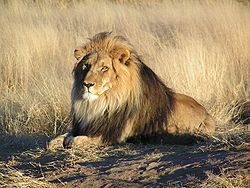
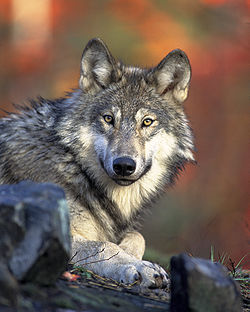
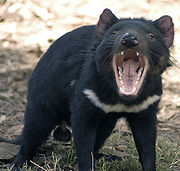
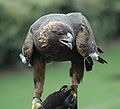

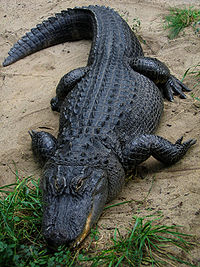
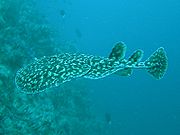
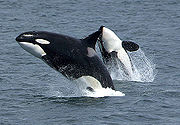
.jpg)
Notes: Animals with an asterisk (*) are only apex predators as introduced species.

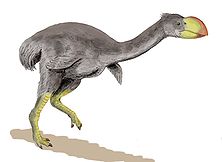
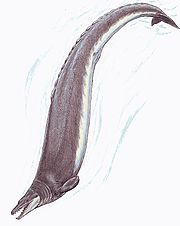
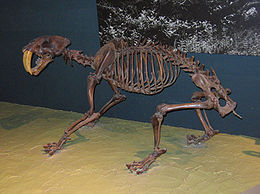
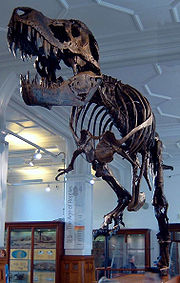
Apex predator
Apex predators are predators that have no predators of their own, residing at the top of their food chain. Zoologists define predation as the killing and consumption of another organism...
s—those predators that are not preyed upon as healthy adults in the wild. Full scavengers (e.g. most vulture
Vulture
Vulture is the name given to two groups of convergently evolved scavenging birds, the New World Vultures including the well-known Californian and Andean Condors, and the Old World Vultures including the birds which are seen scavenging on carcasses of dead animals on African plains...
s), although they may not be preyed on either, are not counted as apex predators unless they at least partially depend on capturing live prey. Many species listed here are only Apex predators within certain environments, e.g. Coyotes are only apex predators when larger predators such as the Gray Wolf
Gray Wolf
The gray wolf , also known as the wolf, is the largest extant wild member of the Canidae family...
or the Brown Bear
Brown Bear
The brown bear is a large bear distributed across much of northern Eurasia and North America. It can weigh from and its largest subspecies, the Kodiak Bear, rivals the polar bear as the largest member of the bear family and as the largest land-based predator.There are several recognized...
are absent.
Extant predators
These living carnivores or omnivores are apex predators.



On land
- African CivetAfrican CivetThe African Civet is the largest representative of the African Viverridae. It is the sole member of its genus. African Civets can be found from coast to coast across sub-Saharan Africa. They are primarily nocturnal and spend the day sleeping in dense vegetation...
- African Lion
- African Rock Python
- African Wild DogAfrican Wild DogLycaon pictus is a large canid found only in Africa, especially in savannas and lightly wooded areas. It is variously called the African wild dog, African hunting dog, Cape hunting dog, painted dog, painted wolf, painted hunting dog, spotted dog, or ornate wolf...
- American BadgerAmerican BadgerThe American badger is a North American badger, somewhat similar in appearance to the European badger. It is found in the western and central United States, northern Mexico and central Canada, as well as in certain areas of southwestern British Columbia.Their habitat is typified by open...
- American Black BearAmerican black bearThe American black bear is a medium-sized bear native to North America. It is the continent's smallest and most common bear species. Black bears are omnivores, with their diets varying greatly depending on season and location. They typically live in largely forested areas, but do leave forests in...
- Arctic FoxArctic foxThe arctic fox , also known as the white fox, polar fox or snow fox, is a small fox native to Arctic regions of the Northern Hemisphere and is common throughout the Arctic tundra biome. The Greek word alopex, means a fox and Vulpes is the Latin version...
- Asian Black Bear
- African Golden CatAfrican Golden CatThe African Golden Cat is a medium-sized wild cat distributed over the rainforests of West and Central Africa. It is about long, and has a tail of about in length...
- Asian Golden Cat
- Black-headed python
- Black MambaBlack mambaThe black mamba , also called the common black mamba or black-mouthed mamba, is the longest venomous snake in Africa, averaging around in length, and sometimes growing to lengths of...
- Blood python
- Boa ConstrictorBoa constrictorThe Boa constrictor is a large, heavy-bodied species of snake. It is a member of the family Boidae found in North, Central, and South America, as well as some islands in the Caribbean. A staple of private collections and public displays, its color pattern is highly variable yet distinctive...
- BobcatBobcatThe bobcat is a North American mammal of the cat family Felidae, appearing during the Irvingtonian stage of around 1.8 million years ago . With twelve recognized subspecies, it ranges from southern Canada to northern Mexico, including most of the continental United States...
- Bornean Clouded LeopardBornean Clouded LeopardThe Sunda clouded leopard , also known as the Sundaland clouded leopard and is a medium-sized wild cat found in Borneo and Sumatra...
- Brown BearBrown BearThe brown bear is a large bear distributed across much of northern Eurasia and North America. It can weigh from and its largest subspecies, the Kodiak Bear, rivals the polar bear as the largest member of the bear family and as the largest land-based predator.There are several recognized...
- Brown Tree SnakeBrown tree snakeThe brown tree snake is an arboreal rear-fanged colubrid snake native to eastern and northern coastal Australia, Papua New Guinea, and a large number of islands in northwestern Melanesia....
* - Burmese PythonBurmese PythonThe Burmese Python is the largest subspecies of the Indian Python and one of the 6 largest snakes in the world, native to a large variation of tropic and subtropic areas of Southern- and Southeast Asia. They are often found near water and are sometimes semi-aquatic, but can also be found in trees...
- Bushmasters
- CaimanCaimanCaimans are alligatorid crocodylians within the subfamily Caimaninae. The group is one of two subfamilies of the family Alligatoridae, the other being alligators. Caimans inhabit Central and South America. They are relatively small crocodilians, with most species reaching lengths of only a few...
- CaracalCaracalThe caracal is a fiercely territorial medium-sized cat ranging over Western Asia, South Asia and Africa.The word caracal comes from the Turkish word "karakulak", meaning "black ear". In North India and Pakistan, the caracal is locally known as syahgosh or shyahgosh, which is a Persian term...
- CatCatThe cat , also known as the domestic cat or housecat to distinguish it from other felids and felines, is a small, usually furry, domesticated, carnivorous mammal that is valued by humans for its companionship and for its ability to hunt vermin and household pests...
* - Chacma BaboonChacma BaboonThe Chacma baboon , also known as the Cape baboon, is, like all other baboons, from the Old World monkey family. With a body length of up to 115 cm and a weight from 15 to 31 kg, it is among the largest and heaviest baboon species. The Chacma is generally dark brown to gray in color,...
- CheetahCheetahThe cheetah is a large-sized feline inhabiting most of Africa and parts of the Middle East. The cheetah is the only extant member of the genus Acinonyx, most notable for modifications in the species' paws...
- ChimpanzeeChimpanzeeChimpanzee, sometimes colloquially chimp, is the common name for the two extant species of ape in the genus Pan. The Congo River forms the boundary between the native habitat of the two species:...
- Clouded LeopardClouded LeopardThe clouded leopard is a felid found from the Himalayan foothills through mainland Southeast Asia into China, and has been classified as vulnerable in 2008 by IUCN...
- Columbian Red Tail Boa
- Cougar
- CoyoteCoyoteThe coyote , also known as the American jackal or the prairie wolf, is a species of canine found throughout North and Central America, ranging from Panama in the south, north through Mexico, the United States and Canada...
- Crab-eating FoxCrab-eating FoxThe crab-eating fox , also known as the forest fox, wood fox, and the common fox, is an extant species of medium-sized canid endemic to the central part of South America and which appeared during the Pliocene epoch...
- Crocodile Monitor
- CulpeoCulpeoThe culpeo , sometimes known as the culpeo zorro or Andean fox , is a South American species of wild dog. It is the second largest native canid on the continent after the maned wolf. In its appearance it bears many similarities to the widely recognized red fox...
* - DholeDholeThe dhole is a species of canid native to South and Southeast Asia. It is the only extant member of the genus Cuon, which differs from Canis by the reduced number of molars and greater number of teats...
- Diamond python
- DingoDingoThe Australian Dingo or Warrigal is a free-roaming wild dog unique to the continent of Australia, mainly found in the outback. Its original ancestors are thought to have arrived with humans from southeast Asia thousands of years ago, when dogs were still relatively undomesticated and closer to...
- DogDogThe domestic dog is a domesticated form of the gray wolf, a member of the Canidae family of the order Carnivora. The term is used for both feral and pet varieties. The dog may have been the first animal to be domesticated, and has been the most widely kept working, hunting, and companion animal in...
- Eastern diamondback rattlesnake
- Eastern WolfEastern WolfThe Eastern Wolf , also known as Eastern Canadian Wolf or Eastern Canadian Red Wolf, may be a subspecies of gray wolf or a distinct species of canid native to the eastern part of North America since the Pleistocene era. It seems to be closely related to the Red Wolf...
- Ethiopian WolfEthiopian WolfThe Ethiopian wolf , also known as the Abyssinian wolf, Abyssinian fox, red jackal, Simien fox, or Simien jackal is a canid native to Africa...
- European Badger
- Eurasian LynxEurasian LynxThe Eurasian lynx is a medium-sized cat native to European and Siberian forests, South Asia and East Asia. It is also known as the European lynx, common lynx, the northern lynx, and the Siberian or Russian lynx...
- FossaFossa (animal)The fossa is a cat-like, carnivorous mammal that is endemic to Madagascar. It is a member of the Eupleridae, a family of carnivorans closely related to the mongoose family . Its classification has been controversial because its physical traits resemble those of cats, yet other traits suggest a...
- Gaboon viper
- Gray WolfGray WolfThe gray wolf , also known as the wolf, is the largest extant wild member of the Canidae family...
- Grizzly BearGrizzly BearThe grizzly bear , also known as the silvertip bear, the grizzly, or the North American brown bear, is a subspecies of brown bear that generally lives in the uplands of western North America...
- Green Anaconda
- Himalayan WolfHimalayan WolfThe terms Himalayan wolf and Canis himalayensis have been suggested by several Indian biologists for recognition as a critically endangered canid species, distinct from Canis lupus...
- Honey Badger
- HumanHumanHumans are the only living species in the Homo genus...
- Indian WolfIndian WolfIndian wolf and Iranian Wolf are two common names for Canis lupus pallipes, a subspecies of grey wolf which inhabits western India, Pakistan, Iran, Turkey, Saudi Arabia and southern Israel. Some experts have suggested at least some C. lupus pallipes populations be re-classified a canid species...
- Indian pythonIndian PythonPython molurus is a large nonvenomous python species found in many tropic and subtropic areas of Southern and Southeast Asia. It is known by the common names Indian python, black-tailed python, and Indian rock python. Two subspecies are currently recognized: the nominate subspecies and the Burmese...
- JackalJackalAlthough the word jackal has been historically used to refer to many small- to medium-sized species of the wolf genus of mammals, Canis, today it most properly and commonly refers to three species: the black-backed jackal and the side-striped jackal of sub-Saharan Africa, and the golden jackal of...
- JaguarJaguarThe jaguar is a big cat, a feline in the Panthera genus, and is the only Panthera species found in the Americas. The jaguar is the third-largest feline after the tiger and the lion, and the largest in the Western Hemisphere. The jaguar's present range extends from Southern United States and Mexico...
- King CobraKing CobraThe king cobra is the world's longest venomous snake, with a length up to 5.6 m . This species, which preys chiefly on other snakes, is found predominantly in forests from India through Southeast Asia to the Philippines and Indonesia...
- Komodo DragonKomodo dragonThe Komodo dragon , also known as the Komodo monitor, is a large species of lizard found in the Indonesian islands of Komodo, Rinca, Flores, Gili Motang and Gili Dasami. A member of the monitor lizard family , it is the largest living species of lizard, growing to a maximum length of in rare cases...
- Lace MonitorLace monitorThe Lace Monitor, or Lace Goanna, Varanus varius, is a member of the monitor lizard family, Australian members of which are commonly known as goannas. It belongs to the subgenus Varanus....
- Large Indian CivetLarge Indian CivetThe Large Indian Civet is a member of the Viverrid family native to Southeast Asia. In 2008, the IUCN classified the species as Near Threatened, mainly because of the known heavy trade as wild meat.- Characteristics :...
- LeopardLeopardThe leopard , Panthera pardus, is a member of the Felidae family and the smallest of the four "big cats" in the genus Panthera, the other three being the tiger, lion, and jaguar. The leopard was once distributed across eastern and southern Asia and Africa, from Siberia to South Africa, but its...
- LynxLynxA lynx is any of the four Lynx genus species of medium-sized wildcats. The name "lynx" originated in Middle English via Latin from Greek word "λύγξ", derived from the Indo-European root "*leuk-", meaning "light, brightness", in reference to the luminescence of its reflective eyes...
- Malabar Large-spotted Civet
- MandrillMandrillThe mandrill is a primate of the Old World monkey family, closely related to the baboons and even more closely to the drill. Both the mandrill and the drill were once classified as baboons in genus Papio, but recent research has determined they should be separated into their own genus, Mandrillus...
- Maned WolfManed WolfThe maned wolf is the largest canid of South America, resembling a large fox with reddish fur.This mammal is found in open and semi-open habitats, especially grasslands with scattered bushes and trees, in south, central-west and south-eastern Brazil The maned wolf (Chrysocyon brachyurus) is the...
- Mulga snake
- Nile MonitorNile monitorThe Nile Monitor, Water Leguaan, or River Leguaan is a large member of the monitor lizard family ....
- OcelotOcelotThe ocelot , pronounced /ˈɒsəˌlɒt/, also known as the dwarf leopard or McKenney's wildcat is a wild cat distributed over South and Central America and Mexico, but has been reported as far north as Texas and in Trinidad, in the Caribbean...
- Olive python
- Ornate MonitorOrnate MonitorThe Ornate Monitor is a species of Monitor lizard, native to West Africa. They live in lowland rainforests. It belongs to the subgenus Polydaedalus along with the Nile Monitor, the Savannah Monitor, and other monitors.-Description:...
- PerentiePerentieThe Perentie is the largest monitor lizard or goanna native to Australia, and fourth largest lizard on earth, after the Komodo Dragon, crocodile monitor and the water monitor...
- Philippine water monitor
- Polar BearPolar BearThe polar bear is a bear native largely within the Arctic Circle encompassing the Arctic Ocean, its surrounding seas and surrounding land masses. It is the world's largest land carnivore and also the largest bear, together with the omnivorous Kodiak Bear, which is approximately the same size...
- RatelRatelThe honey badger , also known as the ratel, is a species of mustelid native to Africa, the Middle East and the Indian Subcontinent. Despite its name, the honey badger does not closely resemble other badger species, instead bearing more anatomical similarities to weasels...
- Red FoxRed FoxThe red fox is the largest of the true foxes, as well as being the most geographically spread member of the Carnivora, being distributed across the entire northern hemisphere from the Arctic Circle to North Africa, Central America, and the steppes of Asia...
- Red WolfRed WolfThe red wolf is a North American canid which once roamed throughout the Southeastern United States and is a glacial period survivor of the Late Pleistocene epoch...
- Reticulated PythonReticulated PythonPython reticulatus, also known as the reticulated python is a species of python found in Southeast Asia. Adults can grow to over 8.7 m in length but normally grow to an average of 3-6 m . They are the world's longest snakes and longest reptile, but are not the most heavily built...
- Scrub python
- ServalServalThe serval , Leptailurus serval or Caracal serval, known in Afrikaans as Tierboskat, "tiger-forest-cat", is a medium-sized African wild cat. DNA studies have shown that the serval is closely related to the African golden cat and the caracal...
- Short-eared DogShort-eared DogThe short-eared dog , also known as the short-eared fox or the short-eared zorro, is a unique and elusive canid species endemic to the Amazonian basin...
- Snow LeopardSnow LeopardThe snow leopard is a moderately large cat native to the mountain ranges of South Asia and Central Asia...
- Spectacled BearSpectacled BearThe spectacled bear , also known as the Andean bear and locally as ukuko, jukumari or ucumari, is the last remaining short-faced bear and the closest living relative to the Florida spectacled bear and short-faced bears of the Middle Pleistocene to Late Pleistocene age.The spectacled bear is a...
- Spotted HyenaSpotted HyenaThe spotted hyena also known as laughing hyena, is a carnivorous mammal of the family Hyaenidae, of which it is the largest extant member. Though the species' prehistoric range included Eurasia extending from Atlantic Europe to China, it now only occurs in all of Africa south of the Sahara save...
- Sun BearSun BearThe sun bear , sometimes known as the honey bear, is a bear found primarily in the tropical rainforests of Southeast Asia; North-East India, Bangladesh, Myanmar, Thailand, Laos, Cambodia, Vietnam, Southern China, Peninsular Malaysia, and the islands of Sumatra and Borneo.-Description:The sun bear...
- TaipanTaipanThe taipans are a genus of large, fast, highly venomous Australasian snakes of the elapid family.-Overview:The taipan was named by Donald Thomson after the word used by the Wik-Mungkan Aboriginal people of central Cape York Peninsula, Queensland, Australia.There are three known species: the coastal...
- Tasmanian DevilTasmanian DevilThe Tasmanian devil is a carnivorous marsupial of the family Dasyuridae, now found in the wild only on the Australian island state of Tasmania. The size of a small dog, it became the largest carnivorous marsupial in the world following the extinction of the thylacine in 1936...
- TigerTigerThe tiger is the largest cat species, reaching a total body length of up to and weighing up to . Their most recognizable feature is a pattern of dark vertical stripes on reddish-orange fur with lighter underparts...
- Tiger QuollTiger QuollThe tiger quoll , also known as the spotted-tail quoll, the spotted quoll, the spotted-tailed dasyure or the tiger cat, is a carnivorous marsupial of the quoll genus Dasyurus native to Australia...
- Water MonitorWater monitorThe Water monitor, is a large species of monitor lizard capable of growing to in length, with the average size of most adults at long. Maximum weight of Varanus salvator can be over , but most are half that size. Their body is muscular with a long, powerful, laterally compressed tail...
- White-throated monitor
- WolverineWolverineThe wolverine, pronounced , Gulo gulo , also referred to as glutton, carcajou, skunk bear, or quickhatch, is the largest land-dwelling species of the family Mustelidae . It is a stocky and muscular carnivore, more closely resembling a small bear than other mustelids...
- Woods rattlesnake
- Yellow anaconda


In the air
- Antarctic Skua
- Bald EagleBald EagleThe Bald Eagle is a bird of prey found in North America. It is the national bird and symbol of the United States of America. This sea eagle has two known sub-species and forms a species pair with the White-tailed Eagle...
- Barred Eagle Owl
- Blakiston's Fish OwlBlakiston's Fish OwlBlakiston's Fish Owl, Bubo blakistoni, is a fish owl, a sub-group of eagle owls who specialized in hunting riparian areas. This species is a part of the family known as typical owls, Strigidae, which contains most species of owl...
- Brown Fish OwlBrown Fish OwlThe Brown Fish Owl is an owl. This species is a part of the family known as typical owls, Strigidae, which contains most living owls. It inhabits the warm subtropical and humid tropical parts of continental Asia and some offshore islands.The four fish owls were previously generally separated in...
- Cape Eagle Owl
- Crested EagleCrested EagleThe Crested Eagle is a large Neotropical eagle. It is the only member of the genus Morphnus. It is 71–89 cm long and has a wingspan of 138–176 cm...
- Crowned Hawk-Eagle
- Eurasian Eagle OwlEurasian Eagle OwlThe Eurasian Eagle-Owl is a species of eagle owl resident in much of Eurasia. It is also one of the largest types of owls.-Description:The Eagle Owl is a large and powerful bird, smaller than the Golden Eagle but larger than the Snowy Owl...
- Forest Eagle Owl
- Giant PetrelGiant petrelGiant petrels is a genus, Macronectes, from the family Procellariidae and consist of two species. They are the largest birds from this family...
- Golden EagleGolden EagleThe Golden Eagle is one of the best known birds of prey in the Northern Hemisphere. Like all eagles, it belongs to the family Accipitridae. Once widespread across the Holarctic, it has disappeared from many of the more heavily populated areas...
- Great Horned OwlGreat Horned OwlThe Great Horned Owl, , also known as the Tiger Owl, is a large owl native to the Americas. It is an adaptable bird with a vast range and is the most widely distributed true owl in the Americas.-Description:...
- Great SkuaGreat SkuaThe Great Skua, Stercorarius skua, is a large seabird in the skua family Stercorariidae. In Britain, it is sometimes known by the name Bonxie, a Shetland name of unknown origin.-Description:...
- Harpy Eagle
- Harrier HawkHarrier HawkThe African Harrier-Hawk, Harrier Hawk, or Gymnogene is a bird of prey. It is about 60–66 cm in length, and is related to the harriers. It breeds in most of Africa south of the Sahara. The only other member of the genus is the allopatric Madagascar Harrier-Hawk.Its habitat is woodland...
- Harris Hawk
- Lappet-faced VultureLappet-faced VultureThe Lappet-faced Vulture or Nubian Vulture is a mostly African Old World vulture belonging to the bird order Accipitriformes, which also includes eagles, kites, buzzards and hawks. It is the only member of the genus Torgos. A distinct subspecies T. t. negevensis occurs in the Sinai, the Negev...
- New Guinea Harpy EagleNew Guinea Harpy EagleThe Papuan Eagle also known as the Papuan Harpy Eagle, New Guinea Eagle, or Kapul Eagle, is a huge greyish brown raptor with a short full crest, broad three-banded wings, powerful beak, large iris, long rounded tail and white underparts. It has long and powerful unfeathered legs with sharp claws...
- OspreyOspreyThe Osprey , sometimes known as the sea hawk or fish eagle, is a diurnal, fish-eating bird of prey. It is a large raptor, reaching more than in length and across the wings...
- Pel's Fish Owl
- Philippine EaglePhilippine EagleThe Philippine Eagle , also known as the Monkey-eating Eagle, is an eagle of the family Accipitridae that is endemic to forests in the Philippines. It has brown and white-coloured plumage, and a shaggy crest, and generally measures in length and weighs...
- Powerful OwlPowerful OwlThe Powerful Owl , also known as the Powerful Boobok, is a species of owl native to south-eastern and eastern Australia, the largest owl on that continent...
- Rock Eagle OwlRock Eagle OwlThe Indian Eagle-Owl also called the Rock Eagle-Owl or Bengal Eagle-Owl is a species of large horned owl found in South Asia. They were earlier treated as a subspecies of the Eurasian Eagle-Owl. They are found in hilly and rocky scrub forests, and are usually seen in pairs. They have a deep...
- Shelley's Eagle Owl
- South Polar SkuaSouth Polar SkuaThe South Polar Skua, Stercorarius maccormicki, is a large seabird in the skua family Stercorariidae. An older name for the bird is MacCormick’s Skua, after explorer and naval surgeon Robert McCormick, who first collected the type specimen...
- Steller's Sea EagleSteller's Sea EagleThe Steller's Sea Eagle, Haliaeetus pelagicus, is a large bird of prey in the family Accipitridae. It lives in coastal northeastern Asia and mainly preys on fish. It is, on average, the heaviest eagle in the world, at about , but often lags behind the Harpy Eagle and Philippine Eagle in other...
- Tawny Fish Owl
- Verreaux's Eagle OwlVerreaux's Eagle OwlVerreaux's Eagle-Owl, Bubo lacteus , is a member of the family Strigidae and is the largest African owl. This owl is claimed to be the world's third largest owl; after the Blakiston's Fish Owl and Eurasian Eagle-Owl.- Description :Verreaux's Eagle-Owl ranges from 66–75 cm in length...
- Wedge-tailed EagleWedge-tailed EagleThe Wedge-tailed Eagle , sometimes known as the Eaglehawk in its native range, is the largest bird of prey in Australia, but it is also found in southern New Guinea. It has long, fairly broad wings, fully feathered legs, and an unmistakable wedge-shaped tail...
- White-tailed EagleWhite-tailed EagleThe White-tailed Eagle , also known as the Sea Eagle, Erne , or White-tailed Sea-eagle, is a large bird of prey in the family Accipitridae which includes other raptors such as hawks, kites, and harriers...



.jpg)
In aquatic environments
- African lungfish
- Alligator Snapping TurtleAlligator Snapping TurtleThe alligator snapping turtle is one of the largest freshwater turtles in the world. It is not closely related to, but is often associated with the common snapping turtle. They are the sole living member of the genus Macrochelys--while common snappers are in the genus Chelydra...
- Alligator GarAlligator garThe Alligator Gar , Atractosteus spatula, is a primitive ray-finned fish. Unlike other Gars, the mature Alligator Gar possesses a dual row of large teeth in the upper jaw. Its name derives from the alligator-like appearance of these teeth along with the fish's elongated snout...
- American AlligatorAmerican AlligatorThe American alligator , sometimes referred to colloquially as a gator, is a reptile endemic only to the Southeastern United States. It is one of the two living species of alligator, in the genus Alligator, within the family Alligatoridae...
- American CrocodileAmerican CrocodileThe American crocodile is a species of crocodilian found in the Neotropics. It is the most widespread of the four extant species of crocodiles from the Americas. Populations occur from the Atlantic and Pacific coasts of southern Mexico to South America as far as Peru and Venezuela. It also lives...
- ArapaimaArapaimaThe arapaima, pirarucu, or paiche is a South American tropical freshwater fish. It is a living fossil and one of the largest freshwater fishes in the world.-Anatomy and morphology:...
- BaijiBaijiBaiji may refer to:* The Baiji or Yangtze River Dolphin * Baiji, Iraq, a city of northern Iraq.* "Baiji" is the pinyin Romanization for Baekje....
(Chinese River Dolphin) - Baikal Seal
- Beluga SturgeonBeluga sturgeonThe beluga or European sturgeon is a species of anadromous fish in the sturgeon family of order Acipenseriformes. It is found primarily in the Caspian and Black Sea basins, and occasionally in the Adriatic Sea...
- Black CaimanBlack CaimanThe black caiman is a crocodilian. It is a carnivorous reptile that lives along slow-moving rivers and lakes, in the seasonally flooded savannas of the Amazon basin, and in other freshwater habitats in South America. Once common, it was hunted to near extinction primarily for its commercially...
- Black grouperBlack grouperThe black grouper is one of the best known of the large group of Perciform fish called groupers.-Description:The black grouper is a large marine fish, growing up to 150 centimetres in length and 100 kilograms in weight. It has an olive or gray body, with black blotches and brassy spots...
- Black MarlinBlack marlinThe black marlin is a species of marlin found in tropical and subtropical Indo-Pacific oceans not far from the surface. It is a large commercial game fish with a maximum published weight of , but greater weights than this have been recorded. It is one of the largest marlins and bony fish...
- Blue MarlinBlue marlinBlue marlin may refer to:* Atlantic blue marlin, Makaira nigricans* Indo-Pacific blue marlin, Makaira mazara, whether or not it is a separate species from Makaira nigricans is currently debated* MV Blue Marlin, a heavy transport ship...
- BotoBotoThe Amazon river dolphin, alternatively Bufeo, Bufeo Colorado, Boto Cor de Rosa, Boutu, Nay, Tonina, or Pink Dolphin , is a freshwater river dolphin endemic to the Orinoco, Amazon and Araguaia/Tocantins River systems of Brazil, Bolivia, Peru, Ecuador, Colombia and Venezuela...
(Amazon river dolphin) - Box JellyfishBox jellyfishBox jellyfish are cnidarian invertebrates distinguished by their cube-shaped medusae. Box jellyfish are known for the extremely potent venom produced by some species: Chironex fleckeri, Carukia barnesi and Malo kingi are among the most venomous creatures in the world...
- Bull SharkBull sharkThe bull shark, Carcharhinus leucas, also known as Zambezi shark or unofficially known as Zambi in Africa and Nicaragua shark in Nicaragua, is a shark common worldwide in warm, shallow waters along coasts and in rivers...
- Common Snapping Turtle
- Electric CatfishElectric catfishElectric catfish is the common name for the catfish family Malapteruridae. This family includes two genera, Malapterurus and Paradoxoglanis with 19 species. Several species of this family have the ability to produce an electric shock of up to 350 volts using electroplaques of an electric organ...
- Electric EelElectric eelThe electric eel , is an electric fish, and the only species of the genus Electrophorus. It is capable of generating powerful electric shocks, of up to six hundred volts, which it uses for both hunting and self-defense. It is an apex predator in its South American range...
- Electric RayElectric rayThe electric rays are a group of rays, flattened cartilaginous fish with enlarged pectoral fins, comprising the order Torpediniformes. They are known for being capable of producing an electric discharge, ranging from as little as 8 volts up to 220 volts depending on species, used to stun prey and...
- False GharialFalse gharialThe false gharial , also known as the Malayan gharial, false gavial, or Tomistoma is a freshwater crocodile of the Crocodylidae family with a very thin and elongated snout...
- False killer whaleFalse Killer WhaleThe False Killer Whale is a cetacean, and the third largest member of the oceanic dolphin family . It lives in temperate and tropical waters throughout the world. As its name implies, the False Killer Whale shares characteristics, such as appearance, with the more widely known Orca...
- Ganges and Indus River dolphinGanges and Indus River DolphinThe South Asian River Dolphin is a freshwater or river dolphin found in India, Nepal and Pakistan which is split into two sub-species, the Ganges River Dolphin and Indus River Dolphin...
- GharialGharialThe gharial , , also called Indian gavial or gavial, is the only surviving member of the once well-represented family Gavialidae, a long-established group of crocodilians with long, slender snouts...
- Giant freshwater stingray
- Giant grouperGiant grouperThe giant grouper , also known as the brindle bass, brown spotted cod, or bumblebee grouper and as the Queensland groper in Australia, is the largest bony fish found in coral reefs, and the aquatic emblem of Queensland, Australia. It is found throughout the Indo-Pacific region, with the exception...
- Giant OtterGiant OtterThe giant otter is a South American carnivorous mammal. It is the longest member of the Mustelidae, or weasel family, a globally successful group of predators. Unusually for a mustelid, the giant otter is a social species, with family groups typically supporting three to eight members...
- Giant Pacific Octopus
- Giant SalamanderGiant salamanderThe hellbender and Asian giant salamanders are aquatic amphibians found in brooks and ponds in the United States, China, and Japan. They are the largest living amphibians known today...
- Giant SnakeheadGiant snakeheadThe giant snakehead or giant mudfish is the largest in the family Channidae, capable of growing to over 1 meter in length and a weight of over 20 kilograms . It is widely distributed in the freshwater of South East Asia and some regions of India...
- Giant TrevallyGiant trevallyThe giant trevally, Caranx ignobilis , is a species of large marine fish classified in the jack family, Carangidae...
- Goliath grouperGoliath grouperThe Atlantic goliath grouper or itajara , commonly known as the Jewfish is a large saltwater fish of the grouper family found primarily in shallow tropical waters among coral and artificial reefs at depths anywhere from 15 to 165 feet...
- Goonch
- Great BarracudaGreat barracudaThe great barracuda is a species of barracuda. Great barracudas often grow over long and are a type of ray-finned fish.-Appearance:...
- Greenland SharkGreenland sharkThe Greenland shark, Somniosus microcephalus, also known as the sleeper shark, gurry shark, ground shark, grey shark, or by the Inuit languages name Eqalussuaq, is a large shark native to the waters of the North Atlantic Ocean around Greenland and Iceland. These sharks live farther north than any...
- Great White SharkGreat white sharkThe great white shark, scientific name Carcharodon carcharias, also known as the great white, white pointer, white shark, or white death, is a large lamniform shark found in coastal surface waters in all major oceans. It is known for its size, with the largest individuals known to have approached...
- HumanHumanHumans are the only living species in the Homo genus...
- Kaluga (fish)Kaluga (fish)The Kaluga is a large predatory sturgeon found in the Amur River basin. Also known as the River Beluga, they are claimed to be the largest freshwater fish in the world, with a maximum size of at least 1,000 kg and 5.6 m . Like the slightly larger Beluga, it spends part of its life in...
- Lake TroutLake troutLake trout is a freshwater char living mainly in lakes in northern North America. Other names for it include mackinaw, lake char , touladi, togue, and grey trout. In Lake Superior, they can also be variously known as siscowet, paperbellies and leans...
- Largemouth BassLargemouth bassThe largemouth bass is a species of black bass in the sunfish family native to North America . It is also known as widemouth bass, bigmouth, black bass, bucketmouth, Potter's fish, Florida bass, Florida largemouth, green bass, green trout, linesides, Oswego bass, southern largemouth...
- Leatherback turtle
- Leopard SealLeopard SealThe leopard seal , also referred to as the sea leopard, is the second largest species of seal in the Antarctic...
- LionfishLionfishLionfish may refer to:* genus Pterois, collectively known as the lionfish* Red Lionfish , a significant invasive species off the East Coast of North America and in the Caribbean-Fish:...
- Loggerhead Sea TurtleLoggerhead Sea TurtleThe loggerhead sea turtle , or loggerhead, is an oceanic turtle distributed throughout the world. It is a marine reptile, belonging to the family Cheloniidae. The average loggerhead measures around long when fully grown, although larger specimens of up to have been discovered...
- MarlinMarlinMarlin, family Istiophoridae, are fish with an elongated body, a spear-like snout or bill, and a long rigid dorsal fin, which extends forward to form a crest. Its common name is thought to derive from its resemblance to a sailor's marlinspike...
- Mediterranean Monk SealMediterranean Monk SealThe Mediterranean monk seal is a pinniped belonging to the Phocidae family. At some 450-510 remaining individuals, it is believed to be the world's second-rarest pinniped , and one of the most endangered mammals in the world.It is present in parts of the Mediterranean Sea and the eastern Atlantic...
- Moray EelMoray eelMoray eels are cosmopolitan eels of the family Muraenidae. The approximately 200 species in 15 genera are almost exclusively marine, but several species are regularly seen in brackish water and a few, for example the freshwater moray can sometimes be found in freshwater...
- Mugger crocodileMugger CrocodileThe mugger crocodile , also called the Indian, Indus, Persian, or marsh crocodile, is found throughout the Indian subcontinent and the surrounding countries...
- Murray CodMurray CodThe Murray cod is a large Australian predatory freshwater fish of the Maccullochella genus and the Percichthyidae family. Although the species is a called cod in the vernacular, it is not related to the northern hemisphere marine cod species...
- MuskellungeMuskellungeA muskellunge , also known as a muskelunge, muscallonge, milliganong, or maskinonge , is a large, relatively uncommon freshwater fish of North America. Muskellunge are the largest member of the pike family, Esocidae...
- Nassau grouperNassau grouperThe Nassau grouper is one of the large number of Perciform fish in the family Serranidae that are commonly referred to as groupers. It is the most important of the groupers for commercial fishery in the West Indies but has been endangered by overfishing.The Nassau grouper is a U.S. National Marine...
- Nile CrocodileNile crocodileThe Nile crocodile or Common crocodile is an African crocodile which is common in Somalia, Ethiopia, Uganda, Kenya, Egypt, Tanzania, Zambia, Zimbabwe, Gabon, South Africa, Malawi, Sudan, Botswana, and Cameroon...
- Nile perchNile perchThe Nile perch is a species of freshwaterfish in family Latidae of order Perciformes. It is widespread throughout muchof the Afrotropic ecozone, being native to the Congo, Nile, Senegal, Niger, and Lake Chad, Volta, Lake Turkana and other river basins. It also occurs in the brackish waters of...
- Northern PikeNorthern PikeThe northern pike , is a species of carnivorous fish of the genus Esox...
- OrcaOrcaThe killer whale , commonly referred to as the orca, and less commonly as the blackfish, is a toothed whale belonging to the oceanic dolphin family. Killer whales are found in all oceans, from the frigid Arctic and Antarctic regions to tropical seas...
- Piraíba catfish
- PseudoplatystomaPseudoplatystomaPseudoplatystoma is a genus of several South American catfish species of family Pimelodidae. The three species are known by a number of different common names. They inhabit the major rivers of north-eastern Argentina, Paraguay, Peru, Bolivia, Uruguay and Brazil. They prefer the main channels and...
(Surubí) - Redtail catfishRedtail catfishThe redtail catfish, Phractocephalus hemioliopterus, is a pimelodid catfish named for its red or orange caudal fin. In Venezuela it is known as cajaro and in Brazil and even in a few parts of Bay of Bengal it is known as pirarara. It is the only extant species of the genus Phractocephalus. This...
- Salmon sharkSalmon sharkThe salmon shark, Lamna ditropis, is a species of shark occurring in the north Pacific ocean. As an apex predator, the salmon shark feeds on salmon, and also on squid, sablefish, and herring...
- Saltwater CrocodileSaltwater CrocodileThe saltwater crocodile, also known as estuarine or Indo-Pacific crocodile, is the largest of all living reptiles...
- SailfishSailfish'Sailfish' are two species of fish in the genus Istiophorus, living in warmer sections of all the oceans of the world. They are predominately blue to gray in color and have a characteristic erectile dorsal fin known as a sail, which often stretches the entire length of the back...
- SawfishSawfishSawfish, also known as the Carpenter Shark, are a family of rays, characterized by a long, toothy nose extension snout. Several species can grow to approximately . The family as a whole is largely unknown and little studied...
- Semutundu catfish
- Smallmouth BassSmallmouth bassThe smallmouth bass is a species of freshwater fish in the sunfish family of the order Perciformes. It is the type species of its genus...
- Sperm WhaleSperm WhaleThe sperm whale, Physeter macrocephalus, is a marine mammal species, order Cetacea, a toothed whale having the largest brain of any animal. The name comes from the milky-white waxy substance, spermaceti, found in the animal's head. The sperm whale is the only living member of genus Physeter...
- SwordfishSwordfishSwordfish , also known as broadbill in some countries, are large, highly migratory, predatory fish characterized by a long, flat bill. They are a popular sport fish of the billfish category, though elusive. Swordfish are elongated, round-bodied, and lose all teeth and scales by adulthood...
- Syrinx aruanusSyrinx aruanusSyrinx aruanus, common name the Australian trumpet or false trumpet, is a species of extremely large sea snail measuring up to 91 cm long and weighing up to 18 kg...
- Tiger SharkTiger sharkThe tiger sharks, Galeocerdo cuvier, is a species of requiem shark and the only member of the genus Galeocerdo. Commonly known as sea tigers, tiger sharks are relatively large macropredators, capable of attaining a length of over . It is found in many tropical and temperate waters, and is...
- TigerfishTigerfishTigerfish is the common name for a variety of species from several different families of fish, usually on account of their colouration or otherwise fearsome appearance and teeth.- Alestiidae :...
- TunaTunaTuna is a salt water fish from the family Scombridae, mostly in the genus Thunnus. Tuna are fast swimmers, and some species are capable of speeds of . Unlike most fish, which have white flesh, the muscle tissue of tuna ranges from pink to dark red. The red coloration derives from myoglobin, an...
- WalleyeWalleyeWalleye is a freshwater perciform fish native to most of Canada and to the northern United States. It is a North American close relative of the European pikeperch...
- Wels catfishWels catfishThe wels catfish , also called sheatfish, is a large catfish found in wide areas of central, southern, and eastern Europe, and near the Baltic and Caspian Seas. It is a scaleless fresh and brackish water fish recognizable by its broad, flat head and wide mouth...
- White grouperWhite grouperThe white grouper is a species of grouper living in the subtropical eastern Atlantic Ocean and the southern Mediterranean Sea...
- White sturgeonWhite sturgeonThe white sturgeon , also known as the Pacific sturgeon, Oregon sturgeon, Columbia sturgeon, Sacramento sturgeon, and California white sturgeon, is a sturgeon which lives along the west coast of North America from the Aleutian Islands to Central...
- VunduVunduThe vundu is a catfish found in the African countries of Niger, Senegal, Egypt, Burundi, the Democratic Republic of the Congo, Tanzania, Uganda, Zimbabwe and Zambia. It is also called the cur, lenda, or certa....
- Zungaro zungaroZungaro zungaroThe Jau is a South American catfish of the family Pimelodidae.-Taxonomy:By some sources, it is the only species of the monotypic genus Zungaro. However, some sources list other species as valid, such as Zungaro jahu. This species may be referred to by one of its synonyms, Brachyplatystoma flavicans...
(Jau)
Notes: Animals with an asterisk (*) are only apex predators as introduced species.
Extinct predators that were likely apex predators
These extinct carnivores or omnivores were apex predators.




- AbelisaurusAbelisaurusAbelisaurus is a genus of abelisaurid theropod dinosaur from the Late Cretaceous Period of what is now South America. It was a bipedal carnivore that probably reached 7 to 9 meters in length, although it is known from only one partial skull.The generic name recognizes Roberto Abel as the...
- AchillobatorAchillobatorAchillobator is a genus of dromaeosaurid theropod dinosaur from the late Cretaceous Period of what is now Mongolia, about 90 million years ago. It was probably an active bipedal predator, hunting with the large sickle-shaped claw on the second toe of each hind foot...
- AcrocanthosaurusAcrocanthosaurusAcrocanthosaurus is a genus of theropod dinosaur that existed in what is now North America during the Aptian and early Albian stages of the Early Cretaceous. Like most dinosaur genera, Acrocanthosaurus contains only a single species, A. atokensis. Its fossil remains are found mainly in the U.S...
- AllosaurusAllosaurusAllosaurus is a genus of large theropod dinosaur that lived 155 to 150 million years ago during the late Jurassic period . The name Allosaurus means "different lizard". It is derived from the Greek /allos and /sauros...
- AlbertosaurusAlbertosaurusAlbertosaurus is a genus of tyrannosaurid theropod dinosaur that lived in western North America during the Late Cretaceous Period, more than 70 million years ago. The type species, A. sarcophagus, was apparently restricted in range to the modern-day Canadian province of Alberta, after which...
- Andrewsarchus
- AnomalocarisAnomalocarisAnomalocaris is an extinct genus of anomalocaridid, which are, in turn, thought to be closely related to the arthropods. The first fossils of Anomalocaris were discovered in the Ogygopsis Shale by Joseph Frederick Whiteaves, with more examples found by Charles Doolittle Walcott in the famed...
- Arctodus simus (Giant Short-faced Bear)
- ArgentavisArgentavisArgentavis magnificens is the largest flying bird ever discovered. This bird, sometimes called the Giant Teratorn, is an extinct species known from three sites from the late Miocene of central and northwestern Argentina, where a good sample of fossils has been obtained.The humerus of...
- Bali TigerBali TigerThe Bali Tiger , harimau Bali in Indonesian, or referred to as samong in archaic Balinese language, was a subspecies of Tiger which was found solely on the small Indonesian island of Bali...
- BaryonyxBaryonyxBaryonyx is a genus of carnivorous saurischian dinosaur first discovered in clay pits just south of Dorking, England, and later reported from fossils found in northern Spain and Portugal. It is known to contain only one species, Baryonyx walkeri...
- BasilosaurusBasilosaurusBasilosaurus is a genus of cetacean that lived from in the Late Eocene. Its fossilized remains were first discovered in the southern United States . The American fossils were initially believed to be some sort of reptile, hence the suffix -"saurus", but later found to be a marine mammal...
- BullockornisBullockornisBullockornis, nicknamed the Demon Duck of Doom, is an extinct flightless bird that appeared to have lived in the Middle Miocene, approximately 15 million years ago, in what is now Australia....
- BrygmophyseterBrygmophyseterBrygmophyseter is an extinct genus of toothed whale in the sperm whale family with one species Brygmophyseter shigensis. When first described, this species was placed in an extinct form genus Scaldicetus of toothed whale, as Scaldicetus shigensis)...
- Cameroceras
- Canis dirusDire WolfThe Dire Wolf, Canis dirus, is an extinct carnivorous mammal of the genus Canis, and was most common in North America and South America from the Irvingtonian stage to the Rancholabrean stage of the Pleistocene epoch living 1.80 Ma – 10,000 years ago, existing for approximately .- Relationships...
(Dire Wolf) - CarcharodontosaurusCarcharodontosaurusCarcharodontosaurus was a gigantic carnivorous carcharodontosaurid dinosaur that lived around 100 to 93 million years ago, during the late Albian to early Cenomanian stages of the mid-Cretaceous Period...
- CryolophosaurusCryolophosaurusCryolophosaurus was a large theropod dinosaur, with a crest on its head that looked like a Spanish comb. Due to the resemblance of this feature to Elvis Presley's pompadour haircut from the 1950s, this dinosaur was at one point informally known as "Elvisaurus".Cryolophosaurus was excavated from...
- DakosaurusDakosaurusDakosaurus is an extinct genus within the family Metriorhynchidae that lived during the Late Jurassic and Early Cretaceous. It was large, with teeth that were serrated and compressed lateromedially . The genus was established by Friedrich August von Quenstedt in 1856 for an isolated tooth named...
- DaspletosaurusDaspletosaurusDaspletosaurus is a genus of tyrannosaurid theropod dinosaur that lived in western North America between 77 and 74 million years ago, during the Late Cretaceous Period. Fossils of the only named species were found in Alberta, although other possible species from Alberta and Montana await...
- DeinonychusDeinonychusDeinonychus was a genus of carnivorous dromaeosaurid dinosaur. There is one described species, Deinonychus antirrhopus. This 3.4 meter long dinosaur lived during the early Cretaceous Period, about 115–108 million years ago . Fossils have been recovered from the U.S...
- DeinosuchusDeinosuchusDeinosuchus is an extinct genus related to the alligator that lived 73 to 80 Ma , during the late Cretaceous period. The name translates as "terrible crocodile" and is derived from the Greek deinos , "terrible", and soukhos , "crocodile"...
- DeltadromeusDeltadromeusDeltadromeus is a genus of large basal ceratosaurian theropod dinosaur from Northern Africa. It had long, unusually slender hind limbs for its size, suggesting that it was a swift runner. The skull is not known. Two fossil specimens of a single species Deltadromeus (meaning "delta runner") is a...
- DilophosaurusDilophosaurusDilophosaurus was a theropod dinosaur from the Sinemurian stage of the Early Jurassic Period, about 193 million years ago. The first specimens were described in 1954, but it was not until over a decade later that the genus received its current name...
- DimetrodonDimetrodonDimetrodon was a predatory synapsid genus that flourished during the Permian period, living between 280–265 million years ago ....
- DinofelisDinofelisDinofelis is a genus of sabre-toothed cats belonging to the tribe Metailurini. They were widespread in Europe, Asia, Africa and North America at least 5 million to about 1.2 million years ago...
- DromaeosaurusDromaeosaurusDromaeosaurus was a genus of theropod dinosaur which lived during the Late Cretaceous period , sometime between 76.5 and 74.8 million years ago, in the western United States and Alberta, Canada. The name means 'running lizard'....
- DryptosaurusDryptosaurusDryptosaurus was a genus of primitive tyrannosaur that lived in Eastern North America during the middle Maastrichtian stage of the Late Cretaceous period. Although largely unknown now outside of academic circles, a famous painting of the genus by Charles R...
- DromornisDromornisDromornis is a genus of prehistoric birds. They stood 3 meters tall and weighed half a ton. Dromornis lived in Australia from the late Miocene to the early Pliocene, meaning that early humans never encountered this genus....
- DunkleosteusDunkleosteusDunkleosteus is a genus of prehistoric fish, one of the largest arthrodire placoderms ever to have lived, existing during the Late Devonian period, about 380-360 million years ago.This hunter, measuring up to and weighing , was a hypercarnivorous apex predator...
- EntelodontEntelodontEntelodonts, sometimes nicknamed hell pigs or terminator pigs, is an extinct family of pig-like omnivores endemic to forests and plains of North America, Europe, and Asia from the middle Eocene to early Miocene epochs , existing for approximately .-Taxonomy:Entelodontidae was named by Richard...
- EotitanosuchusEotitanosuchusEotitanosuchus olsoni is a mammal-like reptile whose fossils were found in the town of Ochyor in Perm Krai, Russia, in channel flood deposits along with Biarmosuchus tener, Estemmenosuchus uralensis and Estemmenosuchus mirabilis.It lived about 255 mya and was a very large animal; although the...
- Falkland Islands Wolf
- GastornisGastornisGastornis is an extinct genus of large flightless bird that lived during the late Paleocene and Eocene epochs of the Cenozoic. It was named in 1855, after Gaston Planté, who had discovered the first fossils in Argile Plastique formation deposits at Meudon near Paris...
- GenyornisGenyornisGenyornis was a monotypic genus of large, flightless bird that lived in Australia until 50±5 thousand years ago. Many species became extinct in Australia around that time, coinciding with the arrival of humans....
- GiganotosaurusGiganotosaurusGiganotosaurus is a genus of carcharodontosaurid dinosaur that lived around 97 million years ago during the early Cenomanian stage of the Late Cretaceous Period. It included some of the largest known terrestrial carnivores, slightly larger than the largest Tyrannosaurus, but smaller than the...
- GorgonopsGorgonopsGorgonops is an extinct genus of therapsid which lived about 255-250 million years ago, during the latest part of the Permian Period. It was a typical representative of the suborder Gorgonopsia, the dominant predators of their day, which in the largest forms grew to over four metres long...
- GorgosaurusGorgosaurusGorgosaurus is a genus of tyrannosaurid theropod dinosaur that lived in western North America during the Late Cretaceous Period, between about 76.5 and 75 million years ago. Fossil remains have been found in the Canadian province of Alberta and possibly the U.S. state of Montana....
- GuanlongGuanlongGuanlong was a genus of proceratosaurid tyrannosauroid dinosaur, one of the earliest known examples of the lineage.-Description and discovery:...
- Haast's EagleHaast's EagleHaast's Eagle was a species of massive eagles that once lived on the South Island of New Zealand. The species was the largest eagle known to have existed. Its prey consisted mainly of gigantic flightless birds that were unable to defend themselves from the striking force and speed of these eagles,...
- Hokkaido Wolf
- Honshu WolfHonshu WolfThe Honshū Wolf, known in Japan as the , , or simply , is one of the two extinct subspecies of the Gray Wolf once endemic to the islands of Japan. The Honshū Wolf occupied the islands of Honshū, Shikoku, and Kyūshū in Japan. The other subspecies is the Hokkaidō Wolf, native to the island of Hokkaidō...
- HomotheriumHomotheriumHomotherium is an extinct genus of machairodontine saber-toothed cats, often termed scimitar cats, endemic to North America, South America, Europe, Asia, and Africa during the Pliocene and Pleistocene epochs , existing for approximately .It first became extinct in Africa some 1.5 million years ago...
- HyaenodonHyaenodonHyaenodon is an extinct genus of Hyaenodonts, a group of carnivorous creodonts of the family Hyaenodontidae endemic to all continents except South America, Australia and Antarctica, living from 42—15.9 mya, existing for approximately .-Morphology:Some species of this genus were amongst the largest...
- IndosuchusIndosuchusIndosuchus is a genus of abelisaurid dinosaur from the Late Cretaceous Period , a theropod related to Abelisaurus. Like most theropods, Indosuchus was a bipedal carnivore...
- IrritatorIrritatorIrritator is a genus of spinosaurid dinosaur that lived in the early Cretaceous Period , around 110 million years ago. Current estimations indicate a length of 8 meters . It was found in Brazil...
- Javan TigerJavan TigerThe Javan tiger is an extinct tiger subspecies that inhabited the Indonesian island of Java until the mid-1970s. It was one of the three subspecies limited to islands.Mazák, J.H., Groves, C.P....
- Joan Wiffen's TheropodJoan Wiffen's TheropodJoan Wiffen's Theropod is a currently unnamed dinosaur that was found by Joan Wiffen in Cretaceous rocks of New Zealand. It is known from one single tail vertebra, and is probably a type of Allosaur, because this is what the tail vertebra seems to resemble most...
- KelenkenKelenkenKelenken is an extinct genus of giant flightless predatory birds of the family Phorusrhacidae or "terror birds".These birds lived in the Middle Miocene, some 15 million years ago, in Argentina along with Argentavis. With a skull 28 inches long , it had the largest head of any known bird...
- KoolasuchusKoolasuchusKoolasuchus is an extinct genus of brachyopoid temnospondyl in the family Chigutisauridae. Fossils have been found from Victoria, Australia and date back 120 Ma to the Aptian stage of the Early Cretaceous. Koolasuchus is the latest known temnospondyl. Koolasuchus is known from several fragments of...
- KronosaurusKronosaurusKronosaurus is an extinct genus of short-necked pliosaur. It was among the largest pliosaurs, and is named after the leader of the Greek Titans, Cronus.-Discovery and species:Kronosaurus lived in the Early Cretaceous Period ....
- KryostegaKryostegaKryostega is a large temnospondyl amphibian from the Early or Middle Triassic of Antarctica. The genus is based on a single specimen collected in 1986 by a team led by paleontologist William H. Hammer of Augustana College, and now housed in the collections of the American Museum of Natural History...
- LiopleurodonLiopleurodonLiopleurodon is a genus of large, carnivorous marine reptile belonging to the Pliosauroidea, a clade of short-necked plesiosaurs. Two species of Liopleurodon lived during the Callovian stage of the Middle Jurassic Period , while the third, L. rossicus, lived during the Late Jurassic...
- MajungasaurusMajungasaurusMajungasaurus is a genus of abelisaurid theropod dinosaur that lived in Madagascar from 70 to 65.5 million years ago, at the end of the Cretaceous Period. Only one species has been identified...
- MapusaurusMapusaurusMapusaurus was a giant carnosaurian dinosaur from the early Late Cretaceous of what is now Argentina. It was similar in size to its close relative Giganotosaurus, with the largest known individuals estimated as over in length and weighing approximately...
- MegalaniaMegalaniaMegalania is a giant extinct goanna or monitor lizard. It was part of a megafaunal assemblage that inhabited southern Australia during the Pleistocene, and appears to have disappeared around 40,000 years ago...
- MegalosaurusMegalosaurusMegalosaurus is a genus of large meat-eating theropod dinosaurs of the Middle Jurassic period of Europe...
- MegalodonMegalodonThe megalodon and ὀδούς ) is an extinct species of shark that lived roughly from 28 to 1.5 million years ago, during the Cenozoic Era .The taxonomic assignment of C...
- MegistotheriumMegistotheriumMegistotherium is an extinct genus of creodonts, the only known species of which is Megistotherium osteothlastes....
- Miracinonyx (American Cheetah)
- MoanasaurusMoanasaurusMoanasaurus was a genus of mosasaur from the Late Cretaceous period. Its fossil remains have been discovered in the North Island of New Zealand. Moanasaurus was a very large mosasaurine known originally from a disarticulated skull, vertebrae, ribs and paddle bones...
- NeanderthalNeanderthalThe Neanderthal is an extinct member of the Homo genus known from Pleistocene specimens found in Europe and parts of western and central Asia...
- NeovenatorNeovenatorNeovenator is a genus of allosauroid dinosaur. Since its discovery on the Isle of Wight, UK, it has become one of the best-known large carnivorous dinosaurs in Europe. Neovenator was at first considered possibly a new species of Megalosaurus. It measured approximately 7.5 meters in length,...
- OrnithosuchusOrnithosuchusOrnithosuchus is an extinct genus of crurotarsan from the Late Triassic Lossiemouth Sandstone of Scotland...
- Panthera onca gombagenzisEuropean jaguarThe European jaguar lived about 1.5 million years ago, and is the earliest known Panthera species from Europe. Fossil remains were first known from the Olivola site in Italy and under the synonym Panthera toscana from other Italian localities. Later specimens have been found in England, Germany,...
(European Jaguar) - Panthera leo atroxAmerican lionThe American lion — also known as the North American lion, Naegele’s giant jaguar or American cave lion — is an extinct lion of the family Felidae, endemic to North America during the Pleistocene epoch , existing for approximately...
(American Lion) - Panthera leo spelaeaCave lionPanthera leo spelaea also known as the European or Eurasian cave lion, is an extinct subspecies of lion known from fossils and many examples of prehistoric art.-Physical characteristics:This subspecies was one of the largest lions...
(European Cave Lion) - PhorusrhacosPhorusrhacosPhorusrhacos was a genus of giant flightless predatory birds that lived in Patagonia, containing the single species Phorusrhacos longissimus. Their closest living relatives are the much smaller seriema birds...
- PoposaurusPoposaurusPoposaurus is a genus of reptile from the Late Triassic of the southwestern United States. It was a crurotarsan archosaur which lived in what is now Wyoming, Utah, Arizona and Texas. The type species, Poposaurus gracilis, was described by M. G. Mehl in 1915. The second species, P...
- PostosuchusPostosuchusPostosuchus, meaning "crocodile from Post ", was a basal archosaur that lived in what is now North America during the middle through to the late Triassic period...
- Predator XPredator XPredator X is a comic book character, in Marvel Comics' main shared universe. The character is an adversary of Marvel's mutant characters, including the X-Men.-History:...
- PropleopusPropleopusPropleopus is an extinct genus of marsupial. Two species are known, P. chillagoensis from the Plio-Pleistocene and P. oscillans from the Pleistocene. In contrast to most other kangaroos, and similar to its small extant relative, the Musky Rat-kangaroo, it was probably omnivorous.-References:*John...
- PterygotusPterygotusPterygotus is the second-largest known eurypterid, or sea scorpion and one of the largest arthropods of all time.-Description:...
- RauisuchusRauisuchidaeRauisuchidae is a group of large predatory Triassic archosaurs, and constitute advanced representatives of the larger group Rauisuchia. There is some disagreement over which genera should be included in the Prestosuchidae, which in Rauisuchidae, and which in the Poposauridae, and indeed whether...
- RhamphosuchusRhamphosuchusRhamphosuchus is an extinct relative of the modern false gharial. It inhabited what is now the Indian sub-continent in the Miocene...
- QuinkanaQuinkanaQuinkana is an extinct genus of mekosuchine crocodile that lived in Australia from ~24 million years ago to ~40,000 years ago. By the Pleistocene Quinkana had become one of the top terrestrial predators of Australia, possessing long legs and ziphodont teeth .Ziphodont teeth tend to arise in...
- SarcosuchusSarcosuchusSarcosuchus is an extinct genus of crocodyliform and distant relative of the crocodile that lived 112 million years ago. It dates from the early Cretaceous Period of what is now Africa and is one of the largest giant crocodile-like reptiles that ever lived...
- SaurornithoidesSaurornithoidesSaurornithoides is a genus of troodontid maniraptoran dinosaur, living during the Late Cretaceous period. These creatures were predators, which could run fast on their hind legs and had excellent sight and hearing...
- SaurosuchusSaurosuchusSaurosuchus is an extinct genus of rauisuchian archosaur in the family Prestosuchidae. With a length of around 7 m , it was the largest rauisuchian, except perhaps for the less well known Fasolasuchus. Like other rauisuchians, Saurosuchus walked on four fully erect limbs...
- SimosuchusSimosuchusSimosuchus is an extinct genus of notosuchian crocodylomorphs from the Late Cretaceous of Madagascar. It is named for its unusually short skull. Fully grown individuals were about in length. The type species is S. clarki, found from the Maevarano Formation in Mahajanga Province.The teeth of S...
- SmilodonSmilodonSmilodon , often called a saber-toothed cat or saber-toothed tiger, is an extinct genus of machairodonts. This saber-toothed cat was endemic to North America and South America, living from near the beginning through the very end of the Pleistocene epoch .-Etymology:The nickname "saber-tooth" refers...
(Saber-toothed Cat) - SpinosaurusSpinosaurusSpinosaurus is a genus of theropod dinosaur which lived in what is now North Africa, from the lower Albian to lower Cenomanian stages of the Cretaceous period, about 112 to 97 million years ago. This genus was first known from Egyptian remains discovered in 1912 and described by German...
- SuchomimusSuchomimusSuchomimus is a genus of large spinosaurid dinosaur with a crocodile-like mouth that lived sometime between 121-112 million years ago, during the late Aptian stage of the Cretaceous period in Africa.-Description:...
- TarbosaurusTarbosaurusTarbosaurus is a genus of tyrannosaurid theropod dinosaur that flourished in Asia about 70 million years ago, at the end of the Late Cretaceous Period. Fossils have been recovered in Mongolia, with more fragmentary remains found further afield in parts of China. Although many species have been...
- TarascosaurusTarascosaurusTarascosaurus is a genus of, perhaps abelisaurid, theropod dinosaur from Late Cretaceous of France.After having in 1988 identified an upper jaw bone found near Pourcieux as belonging to a member of the Abelisauridae, French paleontologist Eric Buffetaut reviewed the known remains of larger...
- Thylacoleo (Marsupial Lion)
- ThylacosmilusThylacosmilusThylacosmilus was a genus of sabre-toothed metatherian predators that first appeared during the Miocene. Remains of the animal have been found in parts of South America, primarily Argentina...
(Marsupial Saber-tooth) - ThylacineThylacineThe thylacine or ,also ;binomial name: Thylacinus cynocephalus, Greek for "dog-headed pouched one") was the largest known carnivorous marsupial of modern times. It is commonly known as the Tasmanian tiger or the Tasmanian wolf...
- TeratornisTeratornisTeratornis merriami was a huge North American teratorn, with a wingspan of around 3.5 to 3.8 meters and a wing area of 17.5 square meters, standing an estimated 75 cm tall and weighing about 15 kg. It was somewhat larger than the extant Andean Condor and nearly two double the weight of the...
- TitanisTitanisTitanis is a large extinct flightless carnivorous bird of the family Phorusrhacidae, endemic to North America during the Blancan stage of the Pliocene living 4.9—1.8 Ma, and died out during the Gelasian Age of the earliest Pleistocene, existing approximately .-Etymology:The generic name, Titanis,...
- TitanoboaTitanoboaTitanoboa, , meaning "titanic boa," is a genus of snake that lived approximately 58 to 60 million years ago, in the Paleocene epoch, a 10-million-year period immediately following the dinosaur extinction event...
- TorvosaurusTorvosaurusTorvosaurus is a genus of large theropod dinosaur that lived during the Late Jurassic period...
- TroodonTroodonTroodon is a genus of relatively small, bird-like dinosaur from the Late Cretaceous period . Discovered in 1855, it was among the first dinosaurs found in North America...
- TylosaurusTylosaurusTylosaurus was a mosasaur, a large, predatory marine lizard closely related to modern monitor lizards and to snakes.-Paleobiology:...
- TyrannosaurusTyrannosaurusTyrannosaurus meaning "tyrant," and sauros meaning "lizard") is a genus of coelurosaurian theropod dinosaur. The species Tyrannosaurus rex , commonly abbreviated to T. rex, is a fixture in popular culture. It lived throughout what is now western North America, with a much wider range than other...
- Ursus maritimus tyrannusUrsus maritimus tyrannusUrsus maritimus tyrannus was a very large fossil subspecies of polar bear, descended from an Arctic population of brown bears. Its name in Latin means tyrant sea bear. The species is mentioned by Björn Kurtén, who assigned it to a Polar bear subspecies, U. m. tyrannus. Its bones have been found in...
(Giant Prehistoric Polar Bear) - Ursus spelaeusCave BearThe cave bear was a species of bear that lived in Europe during the Pleistocene and became extinct at the beginning of the Last Glacial Maximum about 27,500 years ago....
(Cave Bear) - UtahraptorUtahraptorUtahraptor is a genus of theropod dinosaurs, including the largest known members of the family Dromaeosauridae. Fossil specimens date to the upper Barremian stage of the early Cretaceous period...
- VelociraptorVelociraptorVelociraptor is a genus of dromaeosaurid theropod dinosaur that existed approximately 75 to 71 million years ago during the later part of the Cretaceous Period. Two species are currently recognized, although others have been assigned in the past. The type species is V. mongoliensis; fossils...
- ZanabazarZanabazar (dinosaur)Zanabazar is a genus of troodontid dinosaur, which lived during the Late Cretaceous period in Mongolia.Fossils of this theropod have been found in the Nemegt Formation of Mongolia. Originally classified as a new species of the genus Saurornithoides by Rinchen Barsbold in 1974, based on a small...

